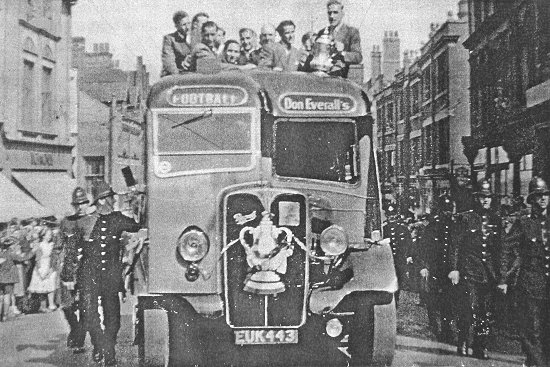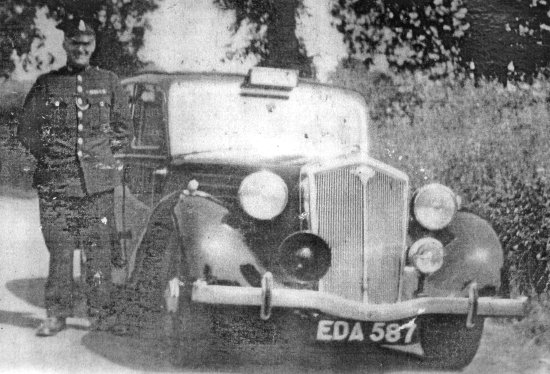|
Life
in the Police
Joe became PC 39, based at Red Lion
Street Police Station, and was issued with his uniform
by Ike Howell, Wolverhampton’s PC 1. He then went for 13
weeks training at Ryton on Dunsmore Police College,
before returning to Wolverhampton to work nights, from
Red Lion Street. At the time it was a poorly paid job,
police constables only earned four pounds ten shillings
a week. As a result many good policemen were leaving to
go into industry where they were paid twice as much.
New recruits were shown the ropes
by a senior constable before they obtained their own
beat. They worked in the suburbs until they gained
experience, before being moved towards the town centre.
It was a tough life, they were expected to be able to
look after themselves. After the war there was much
drunkenness and fighting on the streets at night. Joe
describes his early duties as follows:
“The Wolverhampton people were very
good. We used to go out on parade at a quarter to six in
the morning, a quarter to two in the afternoon, and a
quarter to ten at night. We did a straight 8 hours, 6
days a week. When we marched out, and had our handcuffs
and truncheons checked, with our cape across our arm,
between 12 and 15 policemen marched up Darlington Street
like soldiers, with a sergeant. People used to stand in
Darlington Street and Queen Square to watch. I think
they admired us.
You didn’t move into the town
centre as a young bobby until you had proved you could
work the beat properly. You would start in Chapel Ash,
Merry Hill, and Finchfield, and work the beat regularly,
always next to a senior constable. I started off working
in Brickkiln Street, Worcester Street, and round there.
When the senior man in Darlington Street or Worcester
Street wanted to look round the properties at night, to
check them for security, you moved up a notch to look
after his beat.”
A very important event in Joe’s
life took place on June 2nd, 1947 at St. Philip’s
Church, Penn Fields. He married Margaret who has been
his life-long companion and friend.
|
 |
The scene in Wolverhampton
when Wolves won the F.A. Cup in 1949.
The team with Billie Wright
(Wolves and England Captain) holding the cup, were
escorted from the Low Level Station to the Town Hall
to be received by the Mayor.
The two police officers on
the left are PC 43 Frank Fieldhouse and PC 39 Joe
Davies. Courtesy of Joe Davies. |
|
The
Traffic Department
After two years on the beat, Joe
joined the police traffic department and became a police
driver.
“Sergeant George Llewellyn was in
charge of the mobile side of the borough. He was
earmarked to test about 8 drivers who had already got
licences. I was in a good position because I had been
driving for years. We went out on a test, and he
explained that normally people were sent on an
intermediate course, but he was going to take a gamble
with me, and send me on an advanced course.
It was a 5
week course at a Home Office driving school in Preston,
run by the Lancashire Police. I was a little worried because of
my bad habits, I had never been taught to drive. At
Preston there were 3 or 4 others on the course, all
pre-war bobbies, I was the only post-war bobby there.
After 3 weeks I was worse than ever, but I soon
improved, and came back with a grade 1, the highest
grade. We had a police garage down by the
Molineux, opposite Tin Shop Yard, next to The Fox.
George Lathe had a shop opposite. The workshop was there
as well as some surplus vehicles.”
Joe began working on motor patrol
in a new Wolseley 18, one of the two in the
Wolverhampton force, and greatly enjoyed the experience.
Chief Constable Goodchild, a forward thinking man,
realised that radios would be used in police cars before
the end of 1948. Wolverhampton’s first radio car, one of
the Wolseleys, EDA 587, began operating as a radio car
on 1st September, 1948, and Joe became one of the first
policemen to use a 2-way radio in a police car.
|
| The first patrol car in
Wolverhampton to be fitted with a 2-way radio.
Photo taken in Finchfield Road
in 1948.
Courtesy of Joe Davies. |
 |
|
“It was a bit antiquated, in a
Wolseley 18, built like a big tank. A little bit tail
heavy with all of the batteries in the back, because it
took a lot of power. When you operated the radio it was
a straightforward switch. At the conclusion of your
message you had to lift the switch back up, but a lot of
people got into trouble because they left the switch
down and blotted the whole system out. After 12 months
or so it was altered to a little handset with a trigger.
We worked 9 to 5 on days, and 5 to 1 on nights.
It was a very interesting time, we
did everything. The only way the sergeant at Red Lion
Street could contact the policemen on the beat was by
flashing the boxes, which took time. The boxes were
triangular in shape, one side for the engineer, one side
for the public, and another for the police. There were
72 in the borough, you had to test every one on your
beat, which you opened with a key on your whistle. They
were at focal points, all on junctions so they could be
seen from four directions. Even on motor patrol before
the wireless, you had to keep an eye on them.
The sergeant could instantly
contact us with the radio, so we dealt with everything.
We had a good arrest on our first night on radio patrol.
We were down the Stafford Road when we received a call.
A lorry had been stolen, I can see it now. We were going
towards the Three Tuns out of town, I was with Ernie
Tranter, the PC who was assisting me that night. The
lorry was going up the road the other way, and I said to
Ernie “There’s that lorry”.
|

Joe, briefing the soldiers who
were searching for a missing boy at Bushbury Hill. They
were from West Park Drill Hall. Joe is wearing one of
the early two-way radios. Courtesy of Joe Davies. |
It wasn’t dual carriageway then, so
we turned round by the Three Tuns, but by the time we
got to Oxley Moor Road there was no sign of him. He
hadn’t gone up the Stafford Road, there hadn’t been
time, so we turned into Oxley Moor Road but couldn’t see
it anywhere.
We turned into Renton Road and just caught
sight of his back lights as he turned round a sharp
left-hand bend.
He rammed it straight into the
hedge, got out and went. I said to Ernie “Mind the car,
I’m after him”. I was young and I was fit, and he ran
like hell down the road. I couldn’t see him, so I
wandered gradually back looking behind the walls and the
houses until I found him. The press were quickly on to
this and we got a good article in the paper.
We had a terrific fleet of bikes
when I was serving, they were better than cars, the best
tools because you could nip about, and quickly turn
round. They earned their keep.”
|
 |
|
 |
|
 |
Return to
A New Career |
|
Return to
the contents |
|
Proceed to
Motorcycles |
|